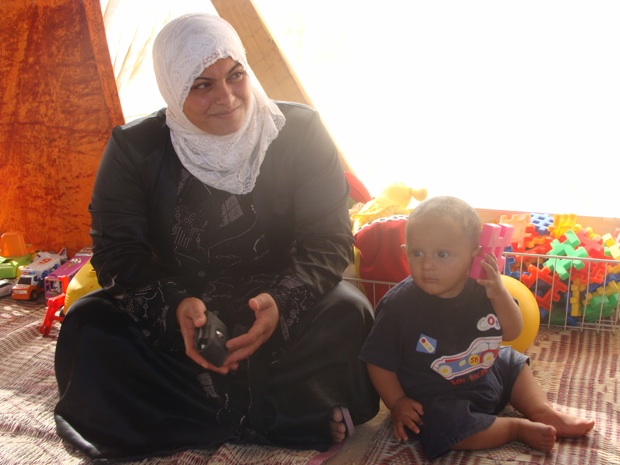The Palestinian Authority’s United Nations bid for statehood is, in a word, divisive. It has set America and Israel adrift from the international community—confirming, yet again, the United States’ deep bias towards Israel. The request is also controversial within Palestinian circles. Even if the bid is successful, will it create meaningful change on the ground? Can it end the occupation? What about equal rights for Palestinian citizens of Israel? What about the Palestinian refugees and their right to return, enshrined in UN resolution 194? And, in light of the fact that few Palestinians feel represented by the PA, is the move legitimate?
Interviews in Ramallah reveal no clear consensus. Still, Abbas’ recent speech to the UN was enthusiastically received in Palestinian cities across the West Bank. For some, it represented, perhaps, a small victory—a moment that the voiceless were given a voice. But this begs the question: which voices are we still not hearing? What are their stories? Who are these people, the Palestinians?
Arthur Neslen’s groundbreaking new book, In Your Eyes a Sandstorm: Ways of Being Palestinian, holds some answers.
A collection of 51 in-depth interviews of Palestinians from all walks of life, In Your Eyes a Sandstorm introduces readers to everyone from a Hamas official, to a Palestinian citizen of Israel who served in the Israeli government, to sisters who were born and raised in Beirut’s Shatila camp, to a drug dealer in East Jerusalem, to a West Bank zoo curator. Candid, colorful, and sometimes surprising, the portraits remind us that Palestinians aren’t the monolithic group that the Western media depicts them as.
Neslen points his attention to Palestinians in the West Bank, Gaza, Israel, Lebanon, and Jordan. While these areas are crawling with journalists, Neslen brings us the stories that go overlooked—like that of Neriman al-Jabari, a 26-year-old widow of an Islamic Jihad leader who was assassinated by Israel in 2004—forcing the reader to interrogate pre-conceived notions about Palestinians.
Neslen’s focus on interviewees in Israel and the Occupied Palestinian Territories serves another purpose. As Neslen points out, location affects both experience and one’s sense of self. The Palestinians nearest to Israel seem to best know “the terror that conflict brings.” Those inside of Israel—an oft-ignored group—wrestle with “identity contradictions that especially afflict Palestinians living close to Israeli Jews.” They also offer a glimpse at the segregation that plagues Israeli society.
As Tamer Nafar, a 29-year-old Palestinian citizen of Israel and founder of the rap group DAM, tells Neslen about his hometown of Lod, just south of Tel Aviv:
“If you buy a map of Lyd, you won’t find the Arabic neighborhoods on it… There are cops here all the time. You have no street lights, unemployment, drugs, and a five-meter-high separation wall between Arab and Jewish areas. You know when someone does something very ugly, and he doesn’t want to look in the mirror? That’s the wall.”
In Your Eyes a Sandstorm also serves as a primer of Palestinian politics, history, and culture, grouping the interviewees by their generation and, thus, the events they have lived through. It’s sophisticated enough to hold the attention of those who are already involved in the issues but accessible to those who have just begun to explore the Israeli-Palestinian conflict. This is a difficult balance to strike and Neslen does so gracefully.
There was, for me, a slight stumble. In the introduction, Neslen describes himself as the son of “left-wing and anti-Zionist Jewish parents.” He also mentions that “trust was often difficult to establish” with his Palestinian interviewees. It’s a catch-22: Neslen can’t not mention these details; but, naturally, some readers might wonder if Neslen’s Jewish background was ever an issue. Was there tension with his interviewees? Why was trust difficult to establish?
One interaction was particularly intriguing. Reflecting upon his interview with an 82-year-old fisherman in Gaza, Neslen remarks, “Strangely and unexpectedly, I felt at home.” This moment seemed worth exploring.
But this is a minor complaint. And Neslen has made the right decision. First off, this book isn’t a memoir. If Neslen had introduced too much of himself, he would have run the danger of his story swallowing up those of his interviewees (a Jew in Gaza! A Jew in Palestinian refugee camps! How does he feel? There’s no room for that but, still, it’s a book I’d like to read).
In Your Eyes a Sandstorm is a gripping look at a society and people who are misrepresented by the mainstream media and misunderstood by much of the Western world. Through these carefully-crafted portraits, Neslen gives Palestinians the space to speak for themselves.


